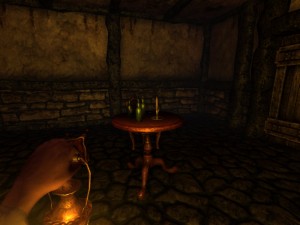Looking for Fear
If I wanted to write about addiction today, my own NPR habit would be an excellent place to begin. News, blogs, radio, podcasts, it’s just so accessible! Today’s entry is not about addiction, but this story does start with “so I was reading NPR News…”
So I was reading NPR News, namely an article titled “What Makes You Feel Fear?” which turned out to be even more intriguing than I expected when I decided to read it. Evidently, researchers have used carbon dioxide inhalation to elicit panic and anxiety in patients with amygdala damage in both hemispheres: patients with no fear centers. How could this be?
This startling discovery comes from a paper published this month in Nature Neuroscience by scientists at the University of Iowa. They tested three patients with Urbach-Wiethe disease (which resulted in bilateral amygdala lesions) by having them inhale CO2. All three experienced panic attacks as a result, and showed significantly increased respiration rates – even with respect to healthy controls. This finding lead the authors to hypothesize that the amygdala may even be able to temporarily inhibit panic, as it has many GABAergic outputs to brainstem regions responsible for panic responses. All of this is pretty stunning. (Of course, the results would have been more stunning if there were a larger group of lesioned patients – all three of them did experience panic attacks in response to the CO2 but so did three of the controls. Fortunately, though, people with bilateral amygdala damage are hard to come by. One could see how a lack of fear could be dangerous!)
The most curious question that this study evokes is whether there is a different mechanism for triggering fear in response to an internal stimulus (like inhaled CO2) than there is for a response to an external stimulus (like a horror movie or a scary video game.) The amygdala is clearly implicated in the processing of inputs and outputs involved in fear responses, but how does it detect what it’s responding to in the first place?

Your amygdala definitely keeps you on the lookout for monsters in computer games like Amnesia: The Dark Descent! (source: amnesia-the-dark-descent.en.softonic.com)
A 2009 study published in Cell investigated this question in mice. Especially in light of the work in humans described above, the results are rather interesting. Another group of scientists looked at the acid-sensitive ion channel ASIC1a in mice as an indicator of the effects of CO2 inhalation because it has been established that CO2 inhalation results in a decrease in blood pH in mammals and generates a fear response. The researchers performed a number of experiments, and showed that the presence of this particular ion channel was necessary to evoke a freezing response in wild-type mice in the presence of 10% CO2 and had no effect on knock-outs. They also looked at context conditioned fear responses with foot shocks – wild-type mice “froze” as expected, but in the presence of 10% CO2 these mice showed freezing behavior before receiving the foot shocks. The next day, when returned to the context in which they were shocked (but not actually given shocks) the mice trained in the presence of CO2 showed more freezing behavior than mice trained without it. In ASIC1a knockouts, the CO2 exposure had no effect on context fear conditioning.
Then, the researchers looked directly at the effects of the CO2 on amygdala pH, and when they confirmed that it was being lowered, they looked at firing rates of cultured amygdala neurons in response to lowered pH and saw an increase in firing as they brought the pH down in wild type cells. In line with these findings, the scientists figured that if low pH increased the fear response, perhaps it could be counteracted by raising amygdala pH with systemic injections of HCO3 –. Indeed, this technique attenuated the fear response to CO2 in wild-type mice but had no effect on knockouts. Lastly, by injecting a virus encoded with the ASIC1a gene to restrict its expression to the basolateral amygdala in knockout mice, the researchers restored the ability of these animals to demonstrate a fear response to inhaled CO2.
All of this seems to indicate interoceptive capabilities in the amygdala. Even so…the knockout mice also showed an increase in ventilation in response to CO2 inhalation, much like the lesioned patients in the human study – so the brain must have other detectors of acidosis…right? After all of this, does the amygdala play a chemosensory role? What other brain regions might be helping it out? Perhaps once we solve these puzzles, physicians may be able to take advantage of our brains’ pH sensitivity to treat panic and anxiety disorders.
What Makes You Feel Fear? – NPR
Fear and panic in humans with bilateral amygdala damage – Nature Neuroscience
The Amygdala Is a Chemosensor that Detects Carbon Dioxide and Acidosis to Elicit Fear Behavior – Cell
